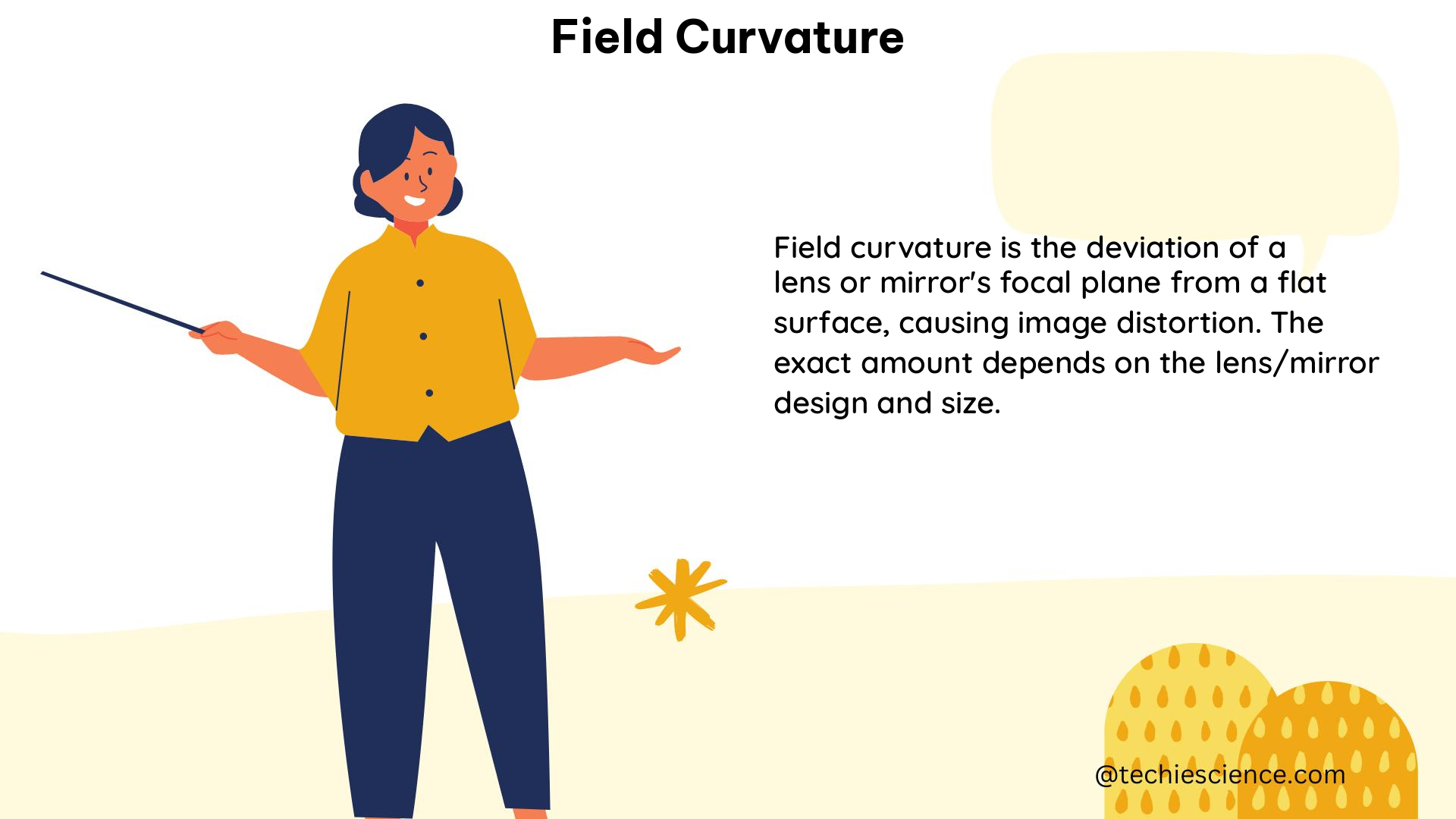Field curvature is a fundamental concept in optics that describes the non-planar nature of the best focus plane across the field of view. This aberration, a third-order Seidel aberration, has a significant impact on the quality of images produced by various optical systems, from cameras and telescopes to prescription glasses and contact lenses. In this comprehensive guide, we will delve into the intricacies of field curvature, exploring its underlying principles, practical implications, and methods for measurement and correction.
The Petzval Field Curvature
The Petzval field curvature is a crucial factor in defining the exact nature of an optical system’s field curvature. This relationship is expressed by the Petzval sum, given by the equation:
$R_{t} = 1/(\Sigma[N_i/R_i])$
Where:
– $R_{t}$ is the radius of the Petzval field curvature
– $N_i$ is the refractive index of the $i$-th lens surface
– $R_i$ is the radius of curvature of the $i$-th lens surface
– $\Sigma$ denotes the summation of the terms
The Petzval sum provides a quantitative measure of the field curvature, allowing optical designers to optimize the lens system and minimize the aberration.
Practical Implications of Field Curvature

Field curvature has significant practical implications in various applications, particularly in photography, astrophotography, and vision correction.
Photography
In photography, field curvature can lead to blurred or distorted images, especially when using wide-angle lenses. When capturing a flat surface, such as a wall or a board, the center of the image may be in focus, while the edges appear slightly blurred. This effect is due to the lens focusing light from all directions onto a flat plane (the image sensor).
Astrophotography
In astrophotography, field curvature affects the view through binoculars or telescopes. When focusing on a star or a celestial object at the center of the field of view, a clear image is achieved. However, as you move away from the center, the image becomes progressively blurred. To counter the effects of field curvature, devices such as field flatteners are used in telescopes, providing a sharp, flat field of view.
Vision Correction
In prescription glasses or contact lenses, the curvatures of the lens surfaces can cause the field of view to appear distorted, especially when the corrective lens does not perfectly match the user’s eye requirements. This can lead to visual discomfort and reduced visual acuity.
Measuring Field Curvature
Measuring field curvature involves analyzing the Modulation Transfer Function (MTF) versus field and focus. This process can be simplified to the assessment of field curvature and astigmatism. Software tools, such as ASTAP, have built-in methods for analyzing field curvature at the imaging plane and coma, which can be useful in correcting the aberration.
MTF Analysis
The Modulation Transfer Function (MTF) is a measure of the contrast transfer characteristics of an optical system. By analyzing the MTF versus field and focus, the field curvature can be quantified. This analysis provides valuable information about the system’s performance and can guide the design and optimization process.
Coma Analysis
Coma is another aberration that can be closely related to field curvature. Software tools like ASTAP can analyze the coma at the imaging plane, which can be useful in understanding and correcting the overall field curvature of the optical system.
Correcting Field Curvature
To mitigate the effects of field curvature, various techniques and devices have been developed:
-
Lens Design Optimization: Optical designers can optimize the lens system by adjusting the curvatures, thicknesses, and refractive indices of the individual lens elements to minimize the Petzval sum and reduce field curvature.
-
Field Flatteners: In astrophotography, field flatteners are used in telescopes to provide a flat, sharp field of view. These devices work by introducing a compensating field curvature that cancels out the inherent field curvature of the telescope’s optics.
-
Adaptive Optics: Advanced adaptive optics systems can dynamically correct for field curvature and other aberrations by using deformable mirrors or other adaptive elements to reshape the wavefront of the incoming light.
-
Image Processing: In some cases, post-processing techniques can be used to correct for field curvature in digital images, such as applying lens distortion correction algorithms or using specialized software.
Conclusion
Field curvature is a fundamental concept in optics that has a significant impact on the quality of images produced by various optical systems. By understanding the underlying principles of field curvature, particularly the Petzval field curvature, and the practical implications in different applications, physicists and optical engineers can design and optimize optical systems to minimize the effects of this aberration. The methods for measuring and correcting field curvature, such as MTF analysis, coma analysis, and the use of field flatteners and adaptive optics, provide valuable tools for improving the performance of optical devices.
References
- Practical Use of Field Curvature Graphs: The 50mm Primes
- Field Curvature – A Practical Guide
- Field Curvature Explained
- Software for Curvature/Coma Correction
- Understanding Field Curvature

The lambdageeks.com Core SME Team is a group of experienced subject matter experts from diverse scientific and technical fields including Physics, Chemistry, Technology,Electronics & Electrical Engineering, Automotive, Mechanical Engineering. Our team collaborates to create high-quality, well-researched articles on a wide range of science and technology topics for the lambdageeks.com website.
All Our Senior SME are having more than 7 Years of experience in the respective fields . They are either Working Industry Professionals or assocaited With different Universities. Refer Our Authors Page to get to know About our Core SMEs.